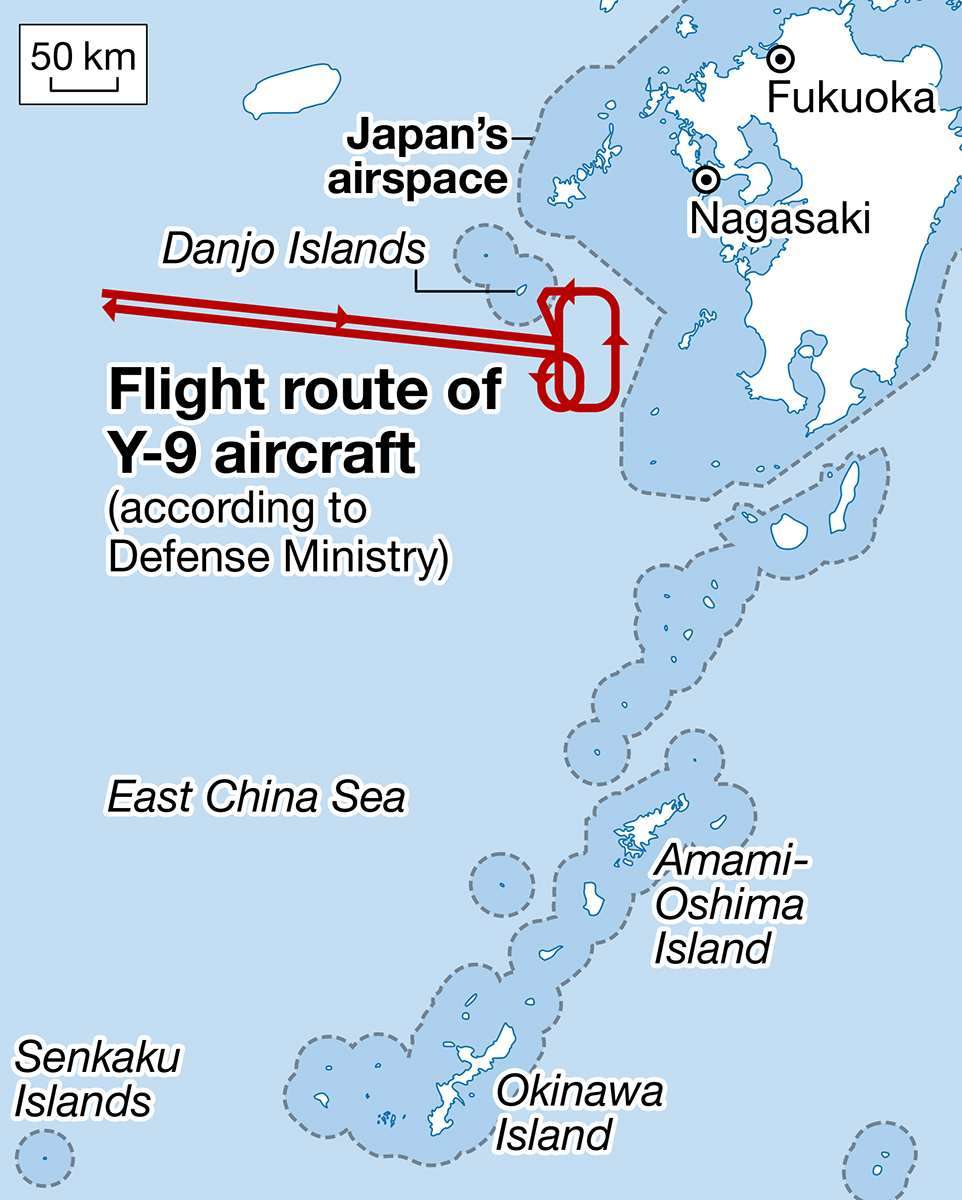Japan Strongly Protests China Military Plane’s Intrusion, Demands Measures Be Taken to Prevent Future Incidents

The Chinese military Y-9 intelligence-gathering aircraft that intruded into Japan’s territorial airspace on Monday
17:41 JST, August 27, 2024
The government has lodged a strong protest with the Chinese government over a military plane’s incursion into Japanese airspace Monday, and demanded Beijing take measures to prevent a recurrence.
The Defense Ministry announced Monday that a Chinese Y-9 intelligence-gathering aircraft violated Japan’s airspace off the Danjo Islands in Nagasaki Prefecture for about two minutes from 11:29 a.m.
Air Self-Defense Force fighters scrambled in response, the ministry said. This is the first time the ministry has confirmed and announced an intrusion into territorial airspace by a Chinese military aircraft.

According to the Defense Ministry’s Joint Staff office, the Y-9 plane came from the direction of China. Around 10:40 a.m., it began circling in the air southeast of the Danjo Islands.
The islands mainly comprise five uninhabited islands about 150 kilometers southwest of Nagasaki.
At about 11:29 a.m., the Y-9 plane intruded into Japan’s airspace from the east of the islets, circled to the left, flew toward the southeast and exited the territorial airspace at around 11:31 a.m.
The Y-9 plane then circled again south of the islets and flew away toward China at around 1:15 p.m.
Just before the Y-9 plane entered Japan’s airspace, ASDF fighters scrambled and notified the Chinese aircraft that it was too close to Japan’s airspace. However, the Y-9 plane continued on its course and eventually entered the territorial airspace. The ASDF fighters therefore warned the aircraft that it must leave.
No other suspicious actions by the Chinese aircraft were confirmed, and the ASDF fighters did not use their weapons.
The ministry did not disclose whether the Y-9 plane responded to the ASDF fighters’ communications.
An aircraft of China’s State Oceanic Administration intruded into Japan’s territorial airspace near Uotsuri Island of the Senkaku Islands in Okinawa Prefecture in December 2012.
In May 2017, a small unmanned aircraft flying near a ship of the China Coast Guard intruded into Japan’s airspace near Uotsuri Island. However, Monday’s incident was the first intrusion by a Chinese military aircraft.
The ministry said it was “analyzing” the Chinese side’s intentions. “[China’s] military activities tend to be on a larger scale and more active. We will make all possible efforts for warning and surveillance,” it said.
Last fiscal year, ASDF fighters scrambled 669 times against aircraft, mainly foreign military planes, which might intrude into Japan’s territorial airspace.
That number was the lowest in the past 10 years, but it was about triple the average during the 2000s.
A total of 479 incidents were caused by Chinese military aircraft last fiscal year, accounting for about 70% of the total.
Vice Foreign Minister Masataka Okano on Monday summoned Acting Chinese Ambassador Shi Yong to the ministry. The ministry announced that Okano lodged a strong protest and demanded measures to prevent a recurrence.
Yasuhiro Kawakami, director of the Security Studies Program at the Sasakawa Peace Foundation and formerly a rear admiral of the Maritime Self-Defense Force, said: “It’s possible that [the Y-9 plane] tried to confirm Japan’s ability to counter.
“There are fears that [the Chinese military] may continue to raise the level of provocation, and this was part of a strategy to build up small changes over a long time and make them accomplished facts.”
An incursion into another country’s airspace happens when an aircraft enters territorial airspace without permission in violation of international law or that specific country’s laws. Territorial airspace is the air over a country’s territorial lands and territorial waters, which stretch about 22 kilometers from coastal lines.
Under international law, a nation has complete and exclusive sovereignty over that airspace.
"Politics" POPULAR ARTICLE
-

Japan to Support Central Asian Logistics Route That Bypasses Russia, Plan to Be Part of Upcoming Summit in Tokyo
-

Japan to Tighten Screening of Foreigners’ Residential Status by Providing Information of Nonpayment of Taxes
-

Chinese, Russian Bombers Flew Unusual Path by Heading Toward Tokyo; Move Likely Meant to Intimidate Japan
-

Japan Plans National Database to Track Foreign Ownership of Real Estate, Land as It Weighs New Rules
-

Up to 199,000 Deaths Estimated From Mega-Tsunami; Most Recent Occurrence Took Place in 17th Century
JN ACCESS RANKING
-

Tokyo Economic Security Forum to Hold Inaugural Meeting Amid Tense Global Environment
-

Keidanren Chairman Yoshinobu Tsutsui Visits Kashiwazaki-Kariwa Nuclear Power Plant; Inspects New Emergency Safety System
-

Imports of Rare Earths from China Facing Delays, May Be Caused by Deterioration of Japan-China Relations
-

University of Tokyo Professor Discusses Japanese Economic Security in Interview Ahead of Forum
-

Japan Pulls out of Vietnam Nuclear Project, Complicating Hanoi’s Power Plans






















